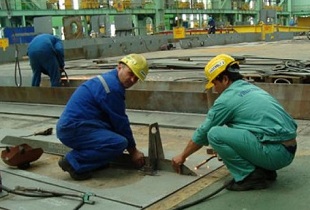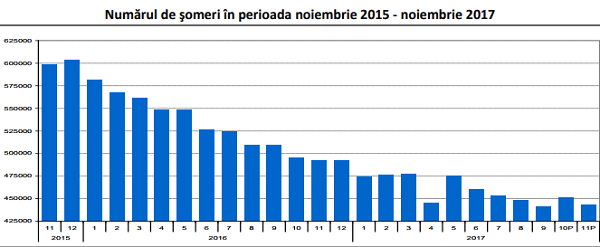 2017 was the first year when the share of foreign (third states) workers initially established – instead of 3,000 permanent workers, as estimated initially based on the employers’ demand, there have been 3,211 people employed. It was a sign that the staff shortage has deepened so much that companies are forced to import workforce, so they can continue their development.
2017 was the first year when the share of foreign (third states) workers initially established – instead of 3,000 permanent workers, as estimated initially based on the employers’ demand, there have been 3,211 people employed. It was a sign that the staff shortage has deepened so much that companies are forced to import workforce, so they can continue their development.
The contingent of newly admitted workers for 2018 was set at 7,000.
The excess over the threshold set in early 2017 has also been determined by the fact that former PM Sorin Grindeanu and Labour Minister Lia Olguta Vasilescu mistakenly estimated the evolution of the labour market – after an annual quota of 3,500 permanent workers has been approved in the previous three years, they reduced the quota of 3,500 to 3,000.
Despite that business people claim a shortage of hundreds of thousands of skilled workers, it was only in 2017 that the threshold of 3,000 employees from third states has been exceeded:
*
- Year permanent workers seconded workers highly skilled personnel
*
After the significant increase (by about 30%) of these demands, the Government set for 2018 a total number of 7,000 foreign workers newly admitted to the Romanian labour market, by 1,500 more than in 2017:
- permanent workers – to 4,000, instead of 3,000
- seconded workers – 1,200, instead of 700 to 1,200
- persons transferred within the same company – 700
- highly skilled workers – 500
- seasonal workers – 400
- trainees – 100
- cross-border workers – 100.
Most of them now – welders. In 2015, governesses predominated, in 2013 – footballers
The main positions, according to the job classification in Romania
2017:
- welder – 253
- locksmith, metal and naval constructions – 252
- restoring carpenter – 167.
2016:
- welder – 136
- governess – 127
- tailor-clothing maker – 120.
2015:
- governess – 151
- agent – 83.
2014:
- welder – 183
- cost price accounting specialist – 149.
2013
- professional footballer – 172
- governess – 113.
Main country of origin in 2017 – Vietnam
By the country of origin, the Vietnamese led by far last year, unlike the previous years, when the Chinese and Turkish were on first places.
The main positions for Vietnamese citizens: locksmith for metal and naval constructions.
For example, the management of the Vard Tulcea shipyard, the largest private employer in the county, hired 190 people last year, of which almost 73% came from the extra-community space.
Now, the company has nearly 3,000 employees, of which 140 are Vietnamese, and intends to increase the staff up to 3,300 people.
They will continue to import Asian workers because they register demands that ensure their production until 2021.
In 2016, when most work permits have been issued to Chinese citizens (501 people), most of them held the position of system and computer engineer designer.
Official and real deficit
The continuation of departures to work abroad has deepened the problem on the labour market year after year, and it is expected for the deficit to increase in the context of a declining unemployment.
The number of vacancies (available on the market) in the third quarter of 2017 was 58,900, according to the INS, by 4,000 fewer than the same period in 2016.
Also, unemployment has also decreased, and in November, according to INS, 443,000 people between 15 and 74 years of age were in such situation:
 Number of unemployed between November 2015-November 2017
Number of unemployed between November 2015-November 2017
On December 29, 2017, only 15,239 jobs were registered at the county employment agencies.
Jobs that are repeatedly launched, as most of them are offers for unskilled or low-skilled workers, paid at the minimum national wage level, such as:
- security agents (1,056)
- commercial workers (891)
- sellers (732)
- unskilled workers in assembling and installing parts (708)
- unskilled workers in the clothing industry (673)
- goods handlers (528)
Employers associations claim that the deficit is in fact of hundreds of thousands of employees. It is difficult to estimate, especially in fields such as construction, which is strongly dependent on state investment.
„At the moment, we have about 350,000 construction workers, maybe more, 370,000-380,000. In reality, a large part of them are not skilled workers. The need to complete the tendered projects (infrastructure -editor’s note) will be of over 600,000 workers. I do not know from where they will come,” said businessman Cristian Erbasu last year.
He accuses the state that stopping investments in recent years made employees in this sector move to the real estate field, so when there will be money available for major infrastructure projects, there will not be skilled people available anymore.
The proof that this stage is over is that big real estate developers do not find workforce either and are forced to bring workers from Vietnam and other Asian countries, but not China, because Chinese workers have already become too expensive for Romania after wages in their country increased much faster than in our country.
Most affected industries
Two of the most affected industries are shipbuilding and HORECA sectors, but causes are extremely different.
Regarding the welders, so needed by the shipbuilders, they are very well paid but left Romania long ago and there are no new ones trained by the Romanian education system.
„After the shipping industry, which is a niche, it follows the HORECA sector, where there is a problem, because most of the companies are owned by Romanians and, even though they have developed very nicely in the last period, they have their specificities. They lost staff, on the one hand, and capital of confidence, on the other hand, which is very serious,” explains Florin Godean.
Therme, City Grill are just a few of the companies that have not found the necessary (skilled) workforce and decided to operate on their own: train their personnel on own expenses, provide employees with trainings and personal development facilities, obtain government accreditations for these aspects – but even so they had, at some point, to recourse to „imports”, even from Asia, including Nepal.
State put all burden on employers
„What is happening now is the result of 27 years of incompetence. Now we need to discuss and see where the situation can be mended.
Causes are many. First, the educational system, which is a national disaster and has produced nothing lately.
Therefore, we are talking about people who are not competent or have no skills and whose wages we need to raise, for us to be competitive.
The state has put everything in charge of the employer, including the role of a professional trainer, although it collects taxes from that employer,” says Florin Godean.
„And, I say again, this is not the question of salary level, but of qualification. Because if we had very well educated and highly skilled people, employers would be prepared to pay the necessary amounts,” adds Adecco representative in Romania.
What else can be done, what others do
„We have already missed the train. There are things that have not been done in time, everybody is arguing about things that should have been solved a long time ago and we see with certain dismay that we still do not find a strategic thinking at the governors’ level, but just some marketing actions and that is all,” Godean says.
However, Romania, with an unemployment rate of 4.9%, is still not at the level of the Czech Republic, where the personnel crisis is even higher, with an unemployment of just 2.5% in November 2017. But the Czech Republic has become an attractive country for workers from poorer member states, Romanians and Bulgarians.
Poland is another country with such problem, which is partially solved by bringing Ukrainians – according to estimates, about one million Ukrainians have been imported in recent years, most of them arriving after the conflicts started in separatist regions, in 2014.
In the city of Kalisz, for example, there were only 527 temporary workers in 2013, and their number went up to nearly 11,000 in 2017.
Not only that it solved the problem of the deficit, but Warsaw also used them as an excuse to deny the takeover of immigrants from the Middle East and Africa. Ukrainians are not refugees though, and the proof is that only a few hundred have requested the refugee status every year.
The Poles are afraid though that Ukrainians would be tempted to emigrate more far, in the West of the EU after they have been given the right to travel to the Union without a visa for 90 days.
That is why Poland is also approaching Asian countries – Nepal, India and Bangladesh – but to bring especially unskilled workforce to the fishing industry and sectors such as the meat or fruit segments.
In the first half of last year, the record level of 4,342 such work permit applications has been reached, by 340 more than the total of 2016.
For Romania, Florin Godean sees only one solution:
„To attract workers from abroad, bring qualified and trained people from there, even if there are additional costs involved.
4,000 people (quota of permanent workers approved for 2018 – editor’s note) mean nothing to the companies’ needs. We are not talking about the development delays, those plans that have not been implemented anymore because there is no workforce anymore.
We should become attractive to specialists from outside of Europe who wish to work in Europe.”










